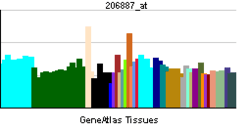CCBP2
| View/Edit Human | View/Edit Mouse |
Chemokine-binding protein 2 is a protein that in humans is encoded by the CCBP2 gene.[3][4][5]
This gene encodes a beta chemokine receptor, which is predicted to be a seven transmembrane protein similar to G protein-coupled receptors. Chemokines and their receptor-mediated signal transduction are critical for the recruitment of effector immune cells to the inflammation site. This gene is expressed in a range of tissues and hemopoietic cells. The expression of this receptor in lymphatic endothelial cells and overexpression in vascular tumors suggested its function in chemokine-driven recirculation of leukocytes and possible chemokine effects on the development and growth of vascular tumors. This receptor appears to bind the majority of beta-chemokine family members; however, its specific function remains unknown. This gene is mapped to chromosome 3p21.3, a region that includes a cluster of chemokine receptor genes.[5]
References
- ↑ "Human PubMed Reference:".
- ↑ "Mouse PubMed Reference:".
- ↑ Bonini JA, Martin SK, Dralyuk F, Roe MW, Philipson LH, Steiner DF (Dec 1997). "Cloning, expression, and chromosomal mapping of a novel human CC-chemokine receptor (CCR10) that displays high-affinity binding for MCP-1 and MCP-3". DNA Cell Biol. 16 (10): 1249–56. doi:10.1089/dna.1997.16.1249. PMID 9364936.
- ↑ Nibbs RJ, Wylie SM, Yang J, Landau NR, Graham GJ (Jan 1998). "Cloning and characterization of a novel promiscuous human beta-chemokine receptor D6". J Biol Chem. 272 (51): 32078–83. doi:10.1074/jbc.272.51.32078. PMID 9405404.
- 1 2 "Entrez Gene: CCBP2 chemokine binding protein 2".
Further reading
- Nibbs RJ, Wylie SM, Pragnell IB, Graham GJ (1997). "Cloning and characterization of a novel murine beta chemokine receptor, D6. Comparison to three other related macrophage inflammatory protein-1alpha receptors, CCR-1, CCR-3, and CCR-5.". J. Biol. Chem. 272 (19): 12495–504. doi:10.1074/jbc.272.19.12495. PMID 9139699.
- Nibbs RJ, Yang J, Landau NR, et al. (1999). "LD78beta, a non-allelic variant of human MIP-1alpha (LD78alpha), has enhanced receptor interactions and potent HIV suppressive activity.". J. Biol. Chem. 274 (25): 17478–83. doi:10.1074/jbc.274.25.17478. PMID 10364178.
- Maho A, Bensimon A, Vassart G, Parmentier M (2000). "Mapping of the CCXCR1, CX3CR1, CCBP2 and CCR9 genes to the CCR cluster within the 3p21.3 region of the human genome.". Cytogenet. Cell Genet. 87 (3-4): 265–8. doi:10.1159/000015443. PMID 10702689.
- Gosling J, Dairaghi DJ, Wang Y, et al. (2000). "Cutting edge: identification of a novel chemokine receptor that binds dendritic cell- and T cell-active chemokines including ELC, SLC, and TECK.". J. Immunol. 164 (6): 2851–6. doi:10.4049/jimmunol.164.6.2851. PMID 10706668.
- Jarmin DI, Rits M, Bota D, et al. (2000). "Cutting edge: identification of the orphan receptor G-protein-coupled receptor 2 as CCR10, a specific receptor for the chemokine ESkine.". J. Immunol. 164 (7): 3460–4. doi:10.4049/jimmunol.164.7.3460. PMID 10725696.
- Homey B, Wang W, Soto H, et al. (2000). "Cutting edge: the orphan chemokine receptor G protein-coupled receptor-2 (GPR-2, CCR10) binds the skin-associated chemokine CCL27 (CTACK/ALP/ILC).". J. Immunol. 164 (7): 3465–70. doi:10.4049/jimmunol.164.7.3465. PMID 10725697.
- Wang W, Soto H, Oldham ER, et al. (2000). "Identification of a novel chemokine (CCL28), which binds CCR10 (GPR2).". J. Biol. Chem. 275 (29): 22313–23. doi:10.1074/jbc.M001461200. PMID 10781587.
- Nibbs RJ, Kriehuber E, Ponath PD, et al. (2001). "The beta-chemokine receptor D6 is expressed by lymphatic endothelium and a subset of vascular tumors.". Am. J. Pathol. 158 (3): 867–77. doi:10.1016/s0002-9440(10)64035-7. PMC 1850343
 . PMID 11238036.
. PMID 11238036. - Homey B, Alenius H, Müller A, et al. (2002). "CCL27-CCR10 interactions regulate T cell-mediated skin inflammation.". Nat. Med. 8 (2): 157–65. doi:10.1038/nm0202-157. PMID 11821900.
- Soler D, Humphreys TL, Spinola SM, Campbell JJ (2003). "CCR4 versus CCR10 in human cutaneous TH lymphocyte trafficking.". Blood. 101 (5): 1677–82. doi:10.1182/blood-2002-07-2348. PMID 12406880.
- Strausberg RL, Feingold EA, Grouse LH, et al. (2003). "Generation and initial analysis of more than 15,000 full-length human and mouse cDNA sequences.". Proc. Natl. Acad. Sci. U.S.A. 99 (26): 16899–903. doi:10.1073/pnas.242603899. PMC 139241
 . PMID 12477932.
. PMID 12477932. - Fra AM, Locati M, Otero K, et al. (2003). "Cutting edge: scavenging of inflammatory CC chemokines by the promiscuous putatively silent chemokine receptor D6.". J. Immunol. 170 (5): 2279–82. doi:10.4049/jimmunol.170.5.2279. PMID 12594248.
- Kunkel EJ, Kim CH, Lazarus NH, et al. (2003). "CCR10 expression is a common feature of circulating and mucosal epithelial tissue IgA Ab-secreting cells.". J. Clin. Invest. 111 (7): 1001–10. doi:10.1172/JCI17244. PMC 152588
 . PMID 12671049.
. PMID 12671049. - Galliera E, Jala VR, Trent JO, et al. (2004). "beta-Arrestin-dependent constitutive internalization of the human chemokine decoy receptor D6.". J. Biol. Chem. 279 (24): 25590–7. doi:10.1074/jbc.M400363200. PMID 15084596.
- Gerhard DS, Wagner L, Feingold EA, et al. (2004). "The status, quality, and expansion of the NIH full-length cDNA project: the Mammalian Gene Collection (MGC).". Genome Res. 14 (10B): 2121–7. doi:10.1101/gr.2596504. PMC 528928
 . PMID 15489334.
. PMID 15489334. - Neil SJ, Aasa-Chapman MM, Clapham PR, et al. (2005). "The promiscuous CC chemokine receptor D6 is a functional coreceptor for primary isolates of human immunodeficiency virus type 1 (HIV-1) and HIV-2 on astrocytes.". J. Virol. 79 (15): 9618–24. doi:10.1128/JVI.79.15.9618-9624.2005. PMC 1181543
 . PMID 16014924.
. PMID 16014924. - Rual JF, Venkatesan K, Hao T, et al. (2005). "Towards a proteome-scale map of the human protein-protein interaction network.". Nature. 437 (7062): 1173–8. doi:10.1038/nature04209. PMID 16189514.
- Kimura K, Wakamatsu A, Suzuki Y, et al. (2006). "Diversification of transcriptional modulation: large-scale identification and characterization of putative alternative promoters of human genes.". Genome Res. 16 (1): 55–65. doi:10.1101/gr.4039406. PMC 1356129
 . PMID 16344560.
. PMID 16344560.
This article incorporates text from the United States National Library of Medicine, which is in the public domain.
